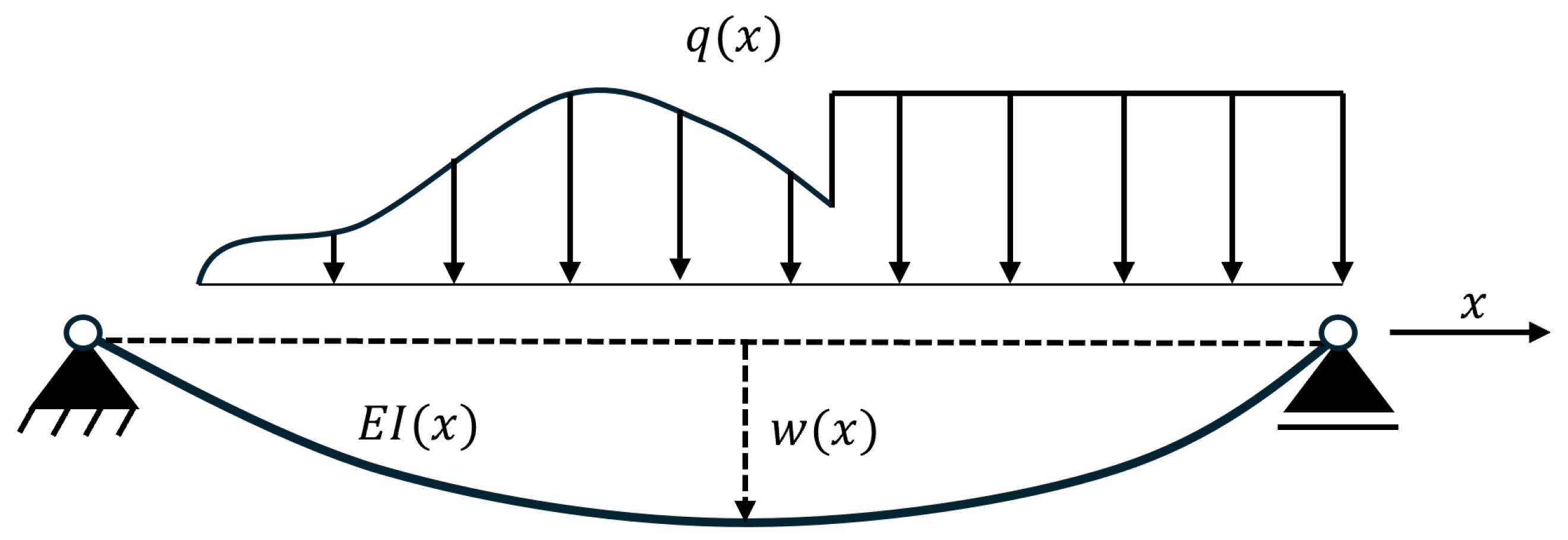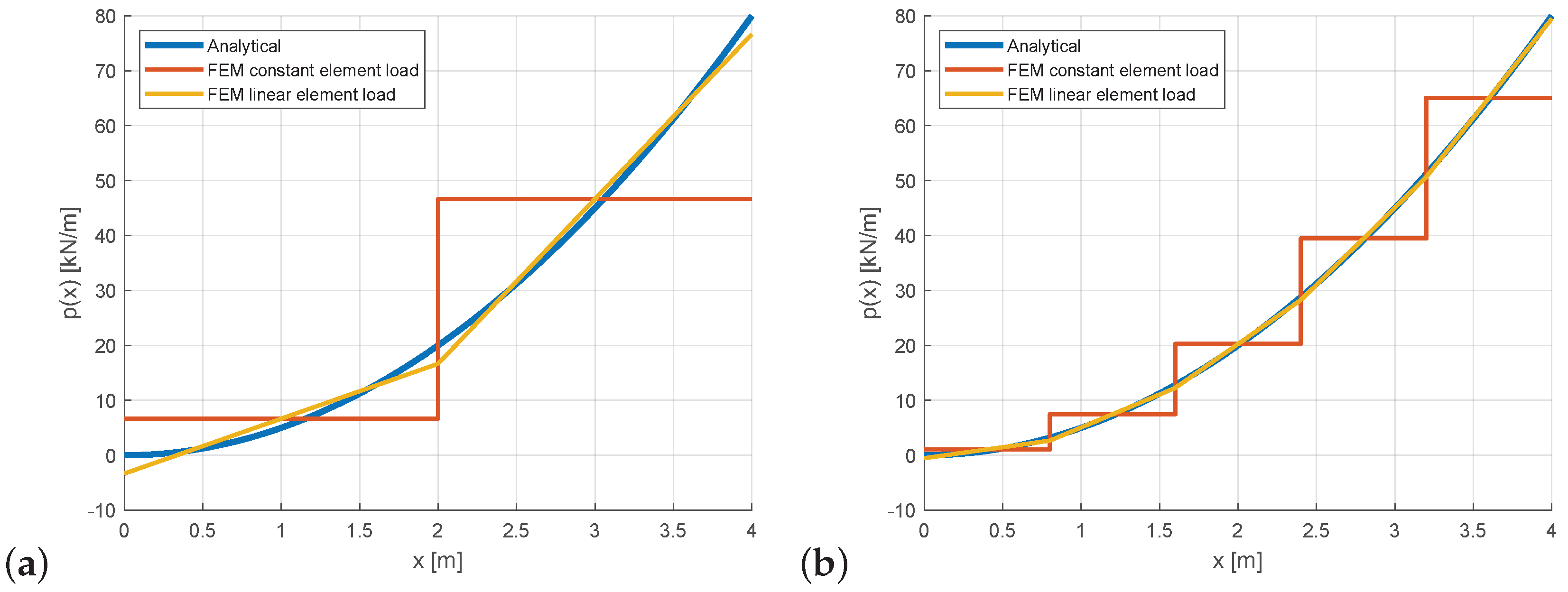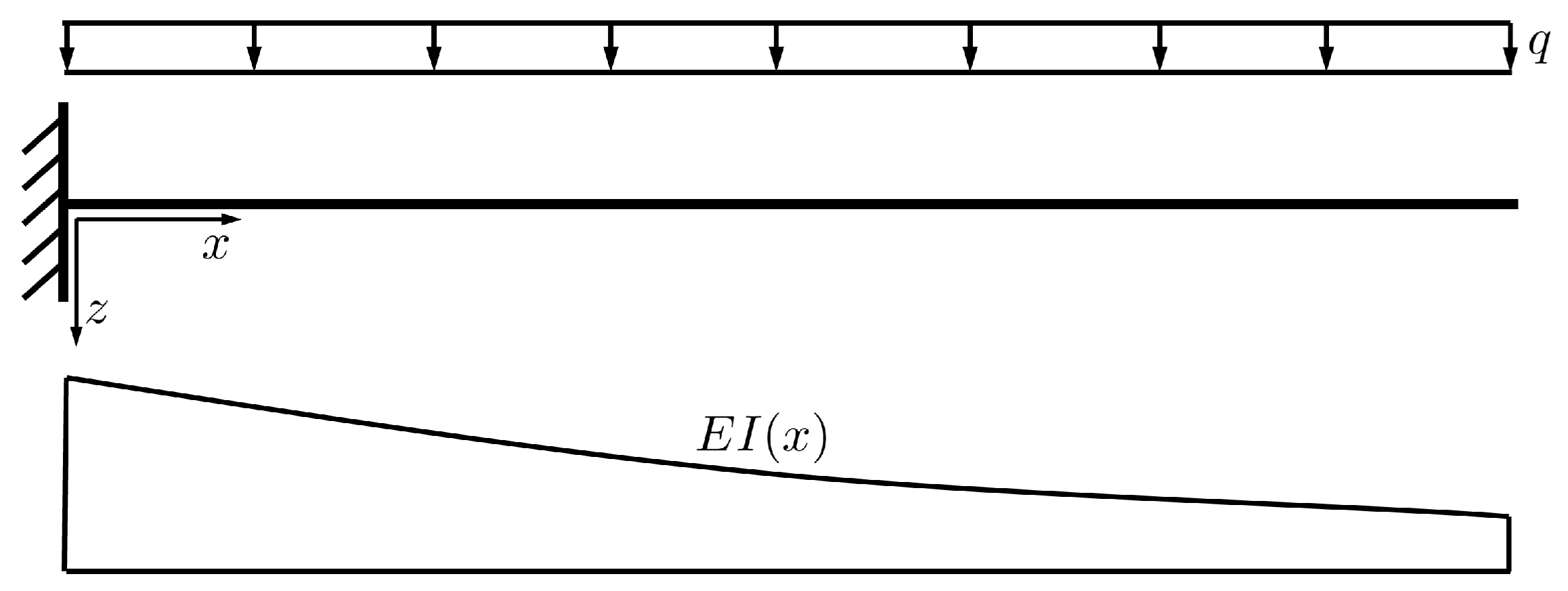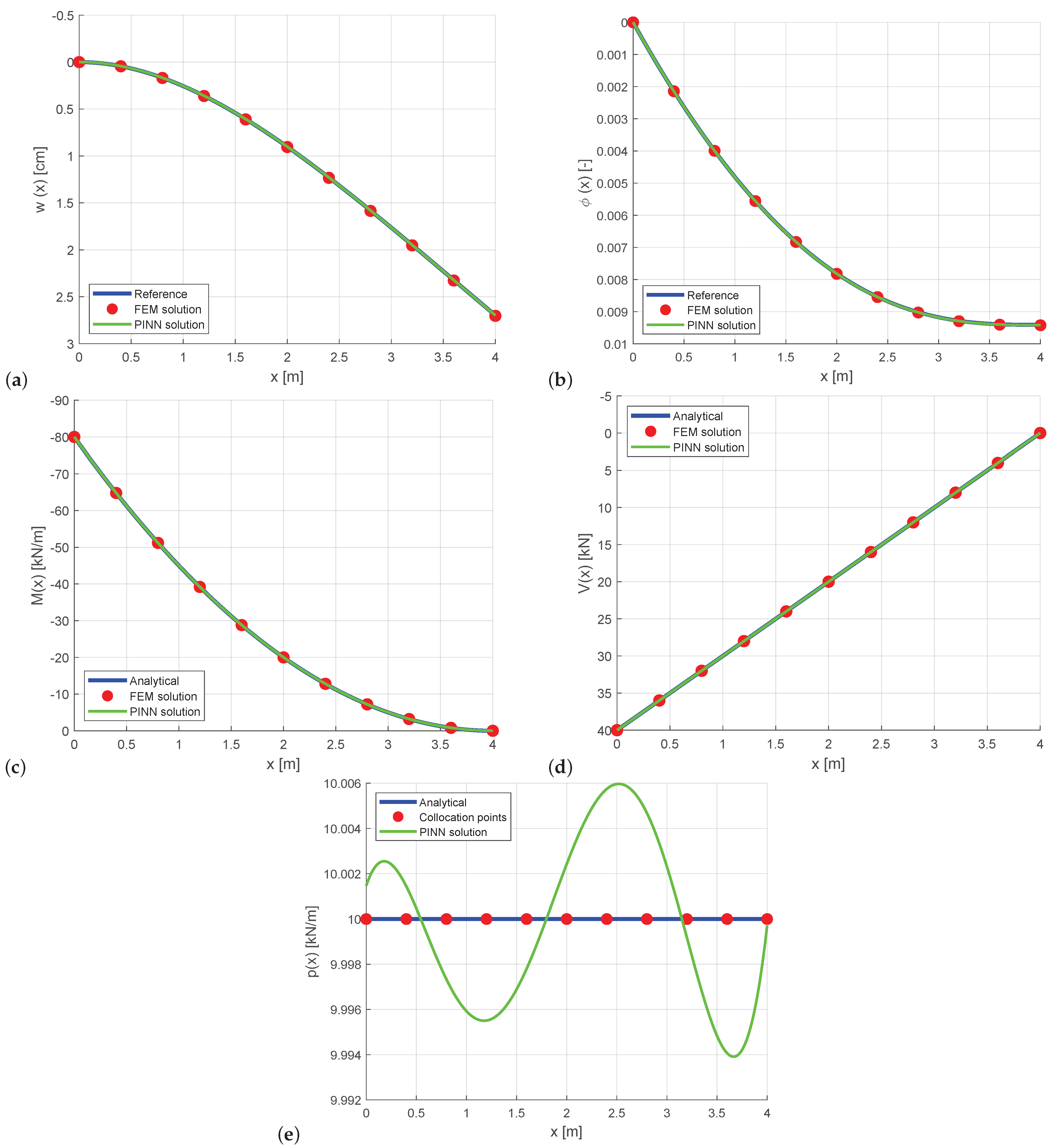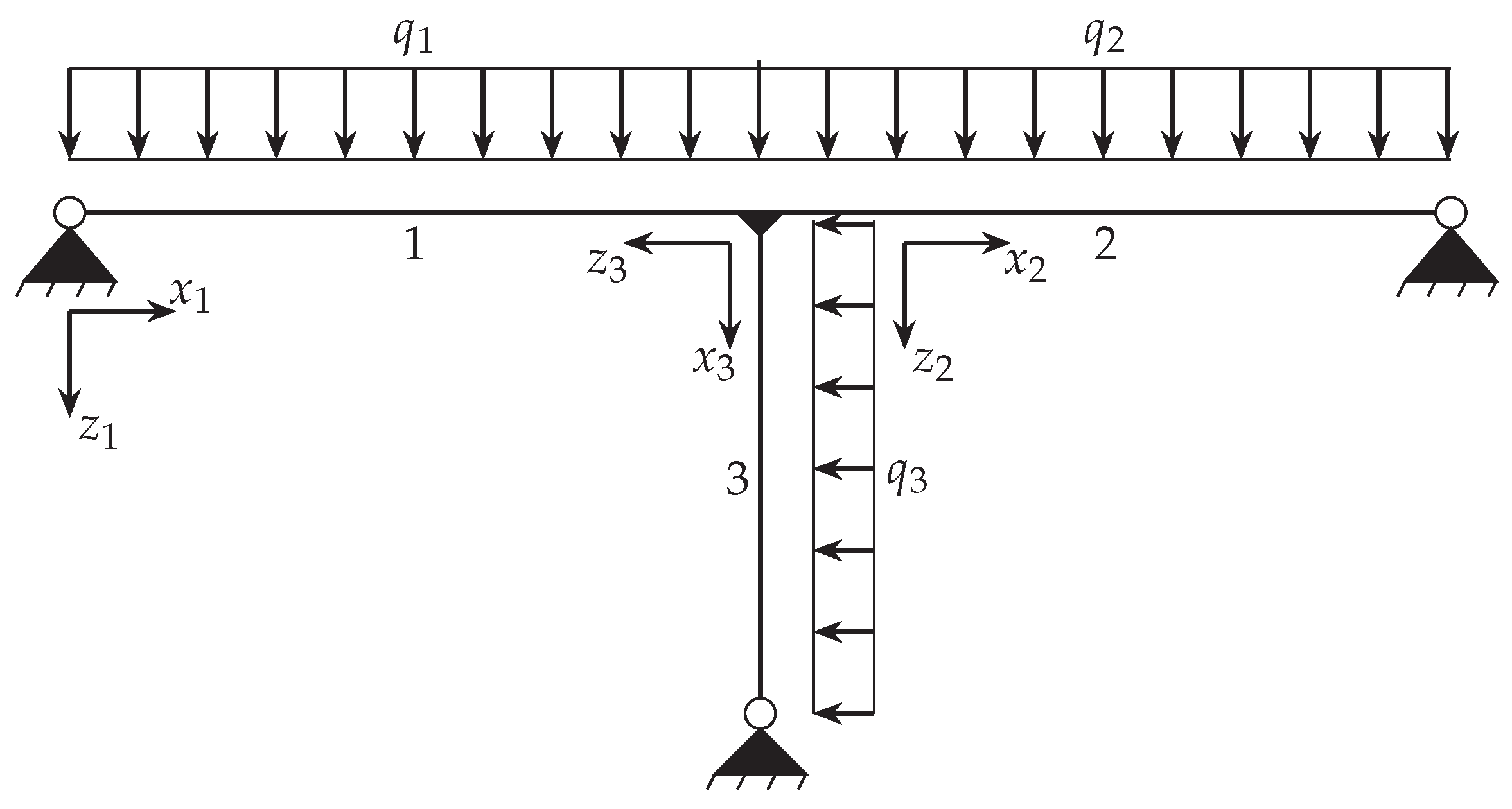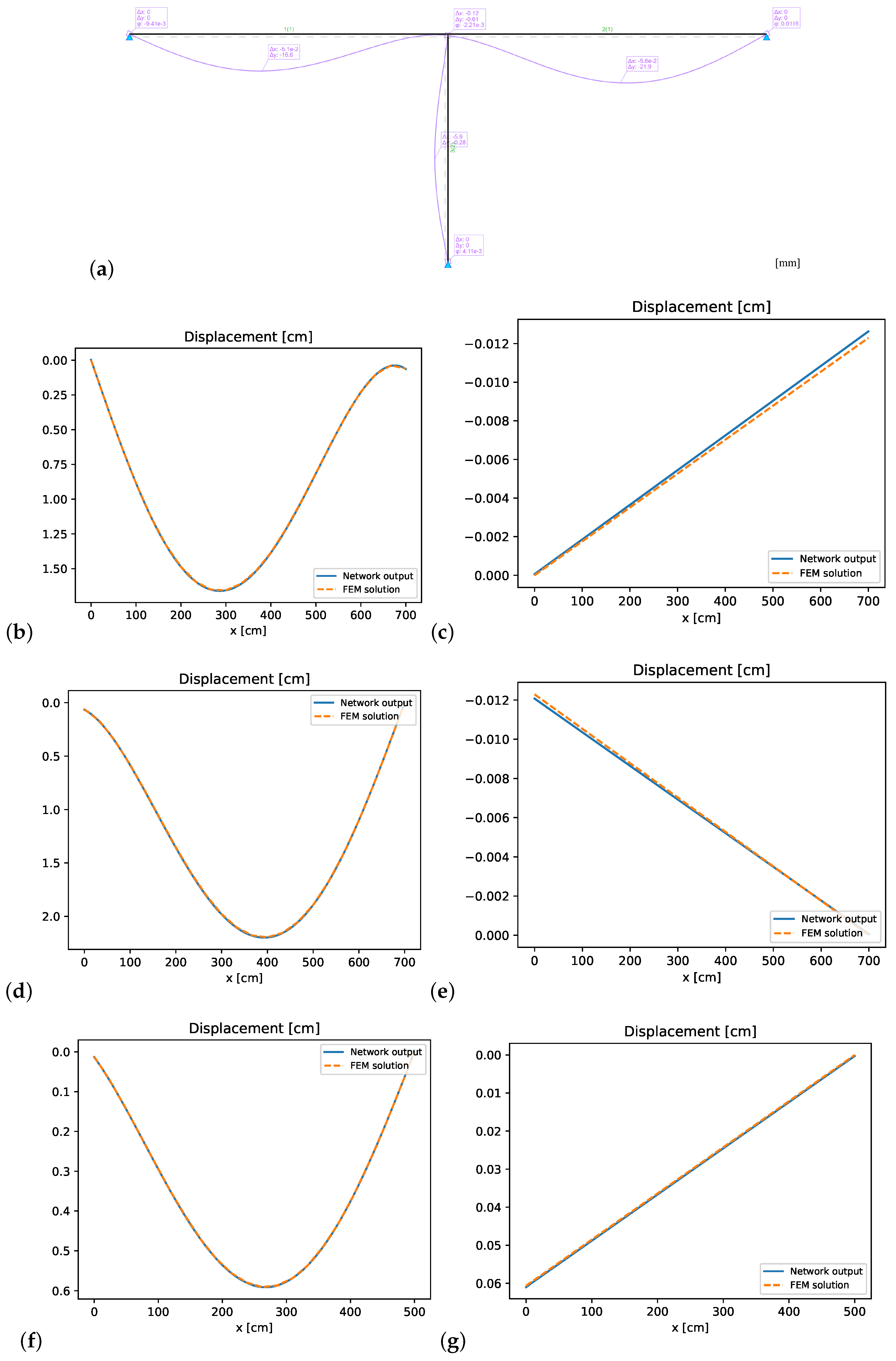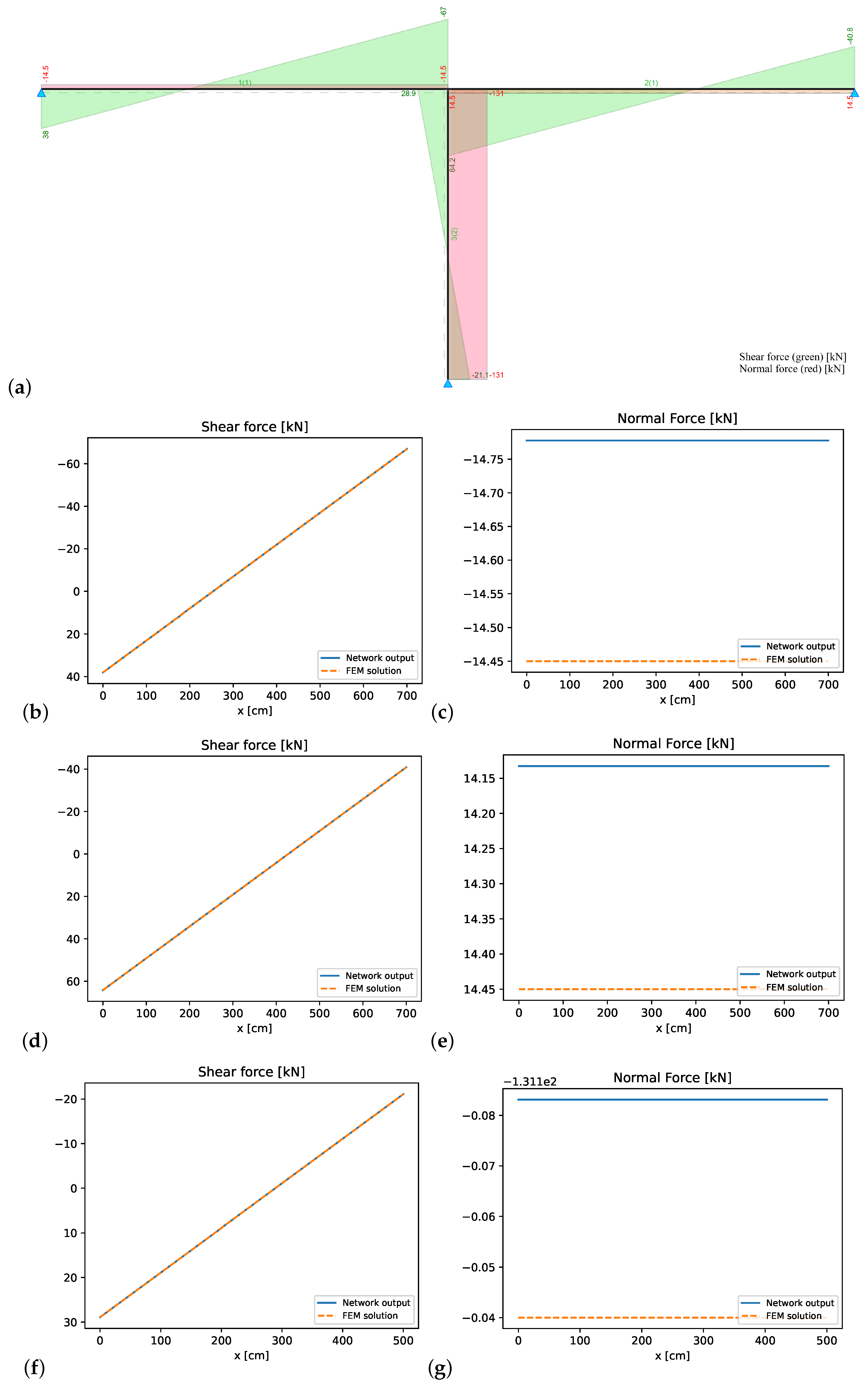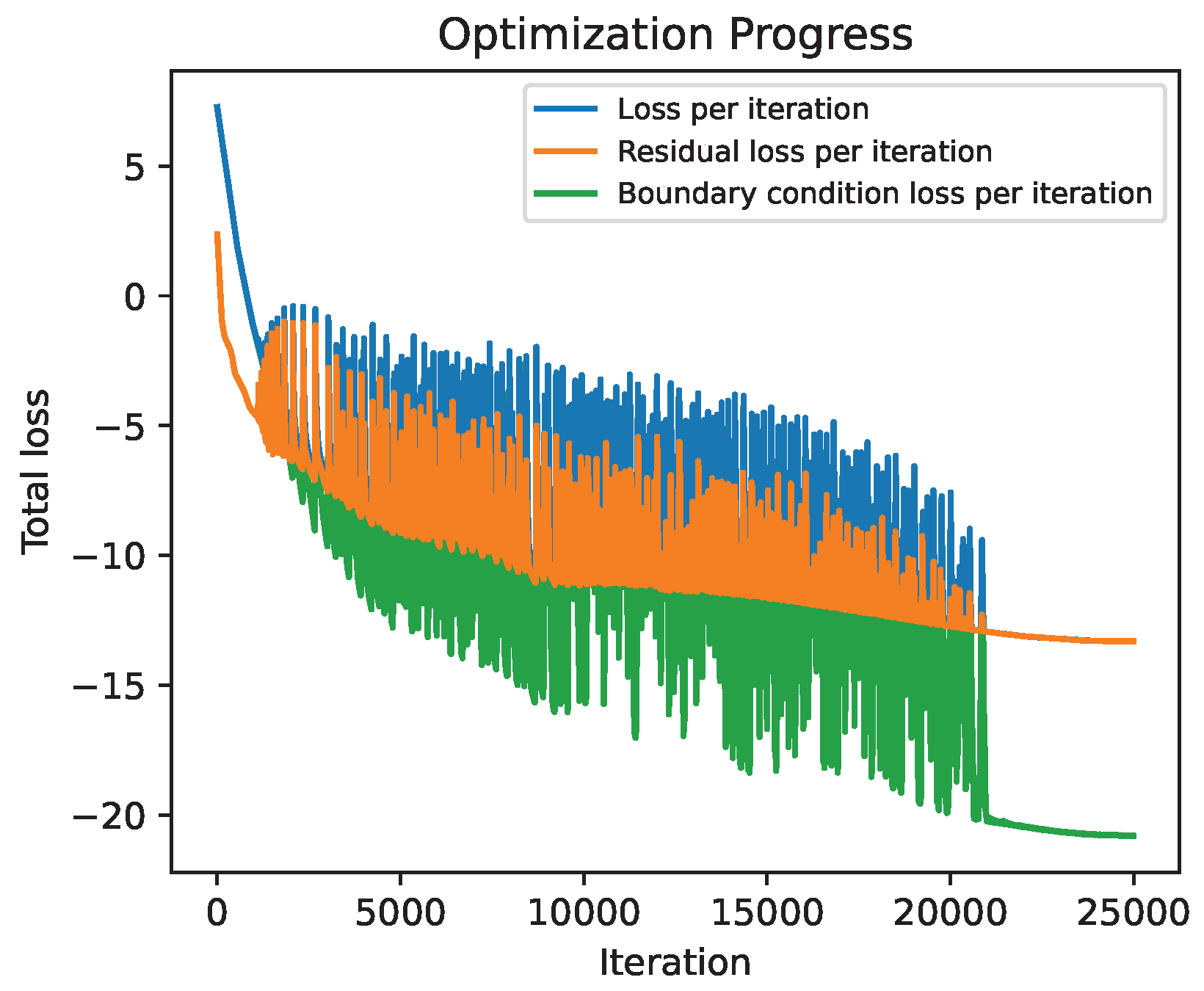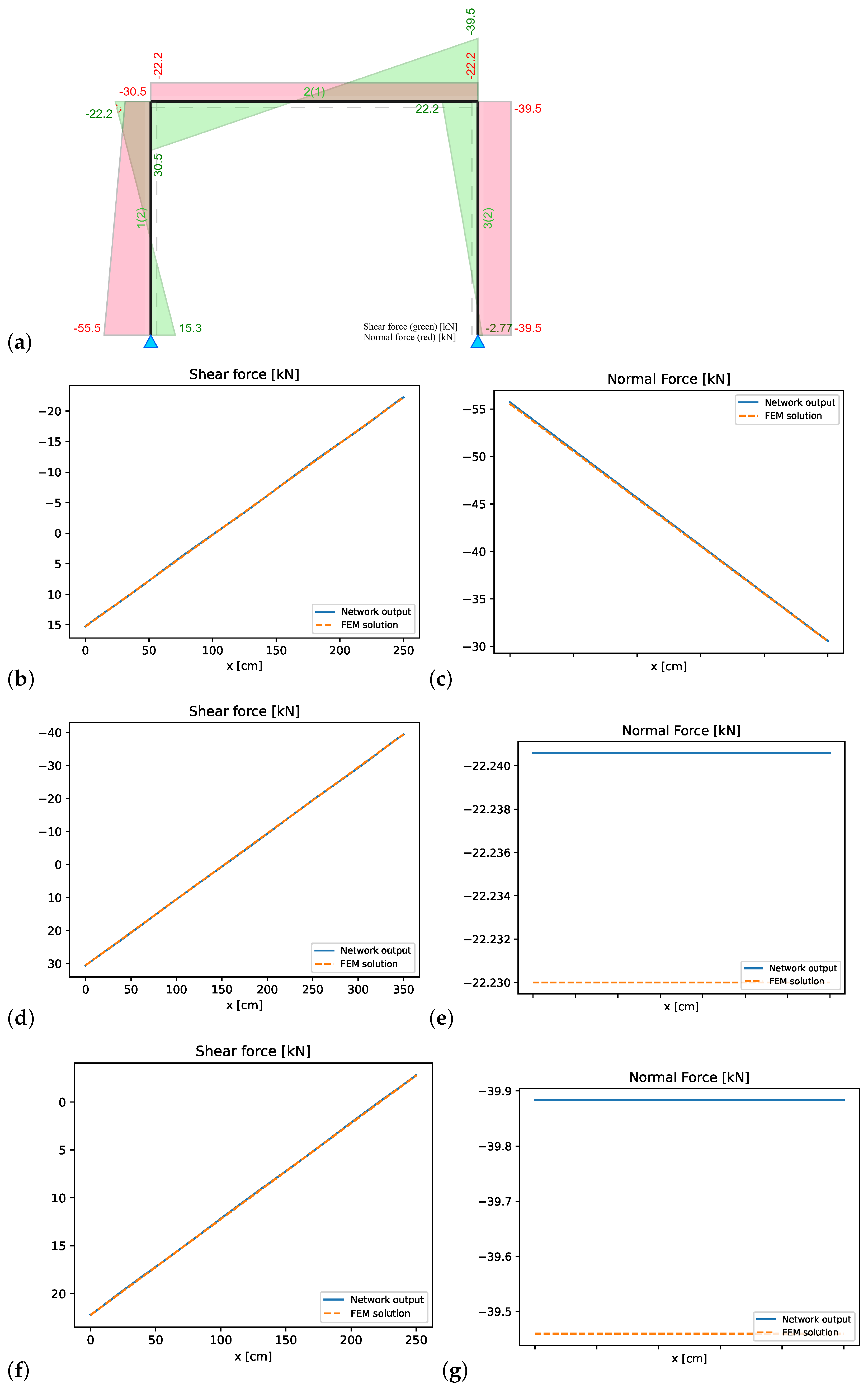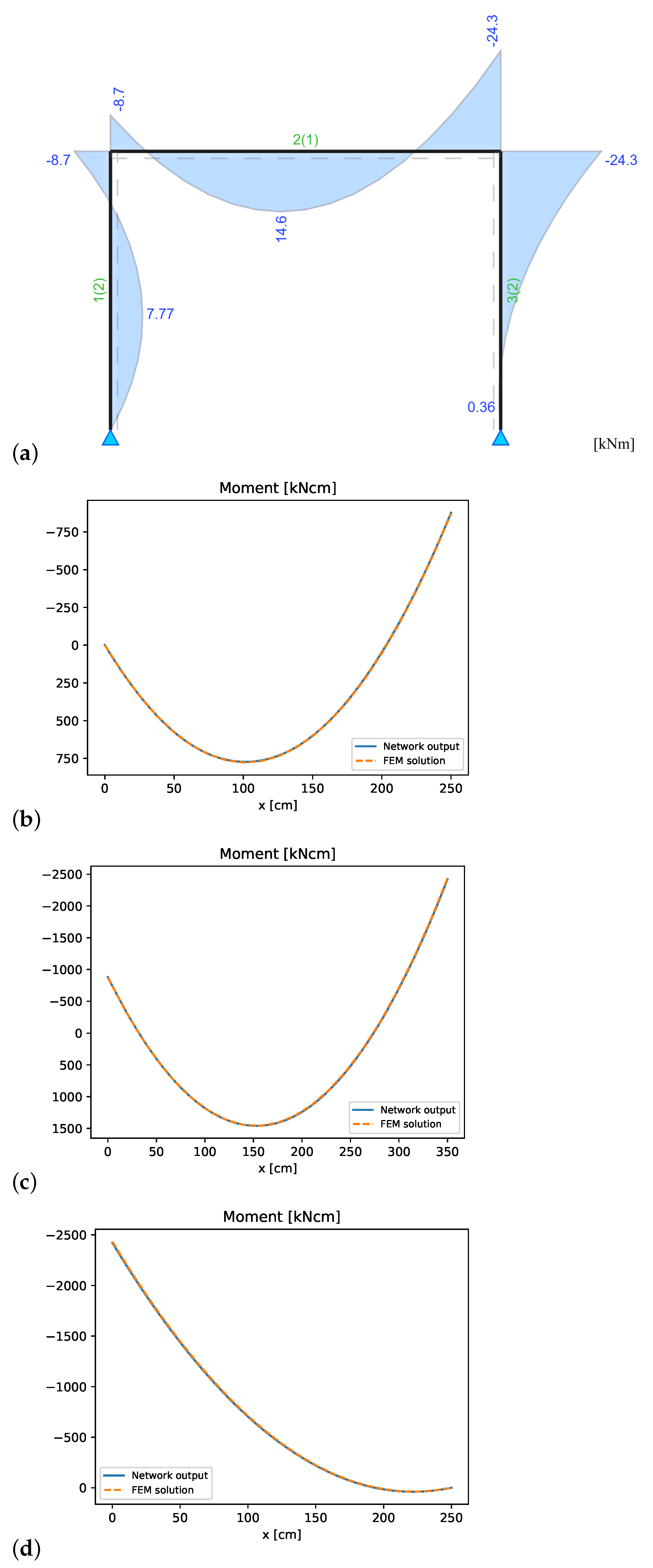Figure 1.
Scheme showing variables of the general bending beam setup. Loading q and bending stiffness are arbitrary functions of coordinate x. The supports can be of various kinds.
Figure 1.
Scheme showing variables of the general bending beam setup. Loading q and bending stiffness are arbitrary functions of coordinate x. The supports can be of various kinds.
Figure 2.
Scheme showing variables for general rod setup. and the axial load n are general functions of the coordinate x.
Figure 2.
Scheme showing variables for general rod setup. and the axial load n are general functions of the coordinate x.
Figure 3.
Network architecture representing the bending deflections of a single beam on the nondimensional length scale . are the linear weights of the input and hidden layers of the network, and and are the corresponding biases and activation functions of the neurons.
Figure 3.
Network architecture representing the bending deflections of a single beam on the nondimensional length scale . are the linear weights of the input and hidden layers of the network, and and are the corresponding biases and activation functions of the neurons.
Figure 4.
PINN training scheme for an example structure with two elements by considering loss function terms for the physics for the boundary conditions for each element as well as for the coupling conditions between the two elements.
Figure 4.
PINN training scheme for an example structure with two elements by considering loss function terms for the physics for the boundary conditions for each element as well as for the coupling conditions between the two elements.
Figure 5.
Cantilever beam with constant bending stiffness subjected to a quadratic load .
Figure 5.
Cantilever beam with constant bending stiffness subjected to a quadratic load .
Figure 6.
Cantilever with quadratic load: approximation of defined load function with constant and linear element loads using (a) two elements and three nodes; (b) five elements and six nodes.
Figure 6.
Cantilever with quadratic load: approximation of defined load function with constant and linear element loads using (a) two elements and three nodes; (b) five elements and six nodes.
Figure 7.
Cantilever with quadratic load: comparison of FEM with six nodes and linear element loads with PINN solution using six collocation points and three hidden neurons for the (a) bending displacement , (b) slope , (c) bending moment , and (d) shear force .
Figure 7.
Cantilever with quadratic load: comparison of FEM with six nodes and linear element loads with PINN solution using six collocation points and three hidden neurons for the (a) bending displacement , (b) slope , (c) bending moment , and (d) shear force .
Figure 8.
Cantilever with quadratic load: PINN approximation of defined load function with (a) three collocation points and five hidden neurons, and (b) six collocation points and three hidden neurons.
Figure 8.
Cantilever with quadratic load: PINN approximation of defined load function with (a) three collocation points and five hidden neurons, and (b) six collocation points and three hidden neurons.
Figure 9.
Cantilever beam with constant load and decreasing bending stiffness .
Figure 9.
Cantilever beam with constant load and decreasing bending stiffness .
Figure 10.
Cantilever with varying stiffness: comparison of FEM with 11 nodes with the PINN solution using 11 collocation points and 5 hidden neurons for the (a) bending displacement , (b) slope , (c) bending moment , (d) shear force , and (e) approximation of load function .
Figure 10.
Cantilever with varying stiffness: comparison of FEM with 11 nodes with the PINN solution using 11 collocation points and 5 hidden neurons for the (a) bending displacement , (b) slope , (c) bending moment , (d) shear force , and (e) approximation of load function .
Figure 11.
T-structure consisting of three beam elements.
Figure 11.
T-structure consisting of three beam elements.
Figure 12.
T-structure: (a) FEM reference solution for displacements, and comparison with PINN results: (b) bending displacements element 1, (c) axial displacements element 1, (d) bending displacements element 2, (e) axial displacements element 2, (f) bending displacements element 3, and (g) axial displacements element 3.
Figure 12.
T-structure: (a) FEM reference solution for displacements, and comparison with PINN results: (b) bending displacements element 1, (c) axial displacements element 1, (d) bending displacements element 2, (e) axial displacements element 2, (f) bending displacements element 3, and (g) axial displacements element 3.
Figure 13.
T-structure: (a) FEM reference solution for shear and normal forces, and comparison with PINN results: (b) shear forces element 1, (c) normal forces element 1, (d) shear forces element 2, (e) normal forces element 2, (f) shear forces element 3, and (g) normal forces element 3.
Figure 13.
T-structure: (a) FEM reference solution for shear and normal forces, and comparison with PINN results: (b) shear forces element 1, (c) normal forces element 1, (d) shear forces element 2, (e) normal forces element 2, (f) shear forces element 3, and (g) normal forces element 3.
Figure 14.
T-structure: (a) FEM reference solution for bending moments, and comparison with PINN bending moments and load functions: (b) bending moment element 1, (c) load function element 1, (d) bending moment element 2, (e) load function element 2, (f) bending moment element 3, and (g) load function element 3.
Figure 14.
T-structure: (a) FEM reference solution for bending moments, and comparison with PINN bending moments and load functions: (b) bending moment element 1, (c) load function element 1, (d) bending moment element 2, (e) load function element 2, (f) bending moment element 3, and (g) load function element 3.
Figure 15.
Optimization convergence history of the logarithmic total loss for the T-structure.
Figure 15.
Optimization convergence history of the logarithmic total loss for the T-structure.
Figure 16.
Double-hinged frame structure.
Figure 16.
Double-hinged frame structure.
Figure 17.
Double-hinged frame: (a) FEM reference solution for displacements, and comparison with PINN results: (b) bending displacements element 1, (c) axial displacements element 1, (d) bending displacements element 2, (e) axial displacements element 2, (f) bending displacements element 3, and (g) axial displacements element 3.
Figure 17.
Double-hinged frame: (a) FEM reference solution for displacements, and comparison with PINN results: (b) bending displacements element 1, (c) axial displacements element 1, (d) bending displacements element 2, (e) axial displacements element 2, (f) bending displacements element 3, and (g) axial displacements element 3.
Figure 18.
Double-hinged frame: (a) FEM reference solution for shear and normal forces, and comparison with PINN results: (b) shear forces element 1, (c) normal forces element 1, (d) shear forces element 2, (e) normal forces element 2, (f) shear forces element 3, and (g) normal forces element 3.
Figure 18.
Double-hinged frame: (a) FEM reference solution for shear and normal forces, and comparison with PINN results: (b) shear forces element 1, (c) normal forces element 1, (d) shear forces element 2, (e) normal forces element 2, (f) shear forces element 3, and (g) normal forces element 3.
Figure 19.
Double-hinged frame: (a) FEM reference solution for bending moments, and comparison with PINN results: (b) element 1, (c) element 2, and (d) element 3.
Figure 19.
Double-hinged frame: (a) FEM reference solution for bending moments, and comparison with PINN results: (b) element 1, (c) element 2, and (d) element 3.
Figure 20.
Double-hinged frame: PINN load function results: (a) transverse load element 1, (b) axial load element 1, (c) transverse load element 2, (d) axial load element 2, (e) transverse load element 3, and (f) axial load element 3.
Figure 20.
Double-hinged frame: PINN load function results: (a) transverse load element 1, (b) axial load element 1, (c) transverse load element 2, (d) axial load element 2, (e) transverse load element 3, and (f) axial load element 3.
Figure 21.
Optimization convergence history of the logarithmic total loss for the double-hinged frame.
Figure 21.
Optimization convergence history of the logarithmic total loss for the double-hinged frame.
Table 1.
Boundary conditions for bending and axial displacements for different support types (adapted from [
30]).
Table 2.
Different examples for the connection of structural elements and the corresponding coupling conditions: (a) two beams with rigid connection, (b) two beams with hinged connection, (c) rigid corner with two elements, and (d) rigid corner with three elements.
Table 3.
System properties of the cantilever beam with quadratic load.
Table 3.
System properties of the cantilever beam with quadratic load.
| Property | Unit | Value |
|---|
| Bending stiffness | Nm2 | |
| Beam length L | m | |
| Quadratic load | kN/m | |
Table 4.
Cantilever with quadratic load: comparison of maximum relative errors in displacement values , slope values , bending moments , shear forces and load values for finite elements with constant and linear element load and the PINN solution with different numbers of collocation points and hidden neurons.
Table 4.
Cantilever with quadratic load: comparison of maximum relative errors in displacement values , slope values , bending moments , shear forces and load values for finite elements with constant and linear element load and the PINN solution with different numbers of collocation points and hidden neurons.
| FEM—Constant element load |
|---|
| Nodes | | | | | | |
| 3 | | | | | | - |
| 6 | | | | | | - |
| 11 | | | | | | - |
| 21 | | | | | | - |
| 51 | | | | | | - |
| 101 | | | | | | - |
| FEM—Linear element load |
| Nodes | | | | | | |
| 3 | | | | | | - |
| 6 | | | | | | - |
| 11 | | | | | | - |
| 21 | | | | | | - |
| 51 | | | | | | - |
| 101 | | | | | | - |
| PINN |
| Collocation points | Neurons | | | | | |
| 3 | 3 | | | | | |
| 6 | 3 | | | | | |
| 11 | 3 | | | | | |
| 21 | 3 | | | | | |
| 51 | 3 | | | | | |
| 101 | 3 | | | | | |
| 3 | 5 | | | | | |
| 6 | 5 | | | | | |
| 11 | 5 | | | | | |
| 21 | 5 | | | | | |
| 51 | 5 | | | | | |
| 101 | 5 | | | | | |
| 21 | 10 | | | | | |
| 51 | 10 | | | | | |
| 101 | 10 | | | | | |
| 51 | 15 | | | | | |
| 101 | 15 | | | | | |
| 101 | 20 | | | | | |
Table 5.
System properties of the cantilever beam with decreasing bending stiffness.
Table 5.
System properties of the cantilever beam with decreasing bending stiffness.
| Property | Unit | Value |
|---|
| Young’s modulus E | kN/cm2 | |
| Beam length L | cm | |
| Beam width b | cm | 10.0 |
| Beam heigth left side | cm | 20.0 |
| Beam heigth right side | cm | 15.0 |
| Constant load q | kN/cm | 0.10 |
Table 6.
Cantilever with varying stiffness: comparison of maximum relative errors in displacement values , slope values , bending moments , shear forces , and load values for finite elements and the PINN solution with different numbers of collocation points.
Table 6.
Cantilever with varying stiffness: comparison of maximum relative errors in displacement values , slope values , bending moments , shear forces , and load values for finite elements and the PINN solution with different numbers of collocation points.
| FEM |
|---|
| Nodes | | | | | | |
| 6 | | | | | | - |
| 11 | | | | | | - |
| 21 | | | | | | - |
| 51 | | | | | | - |
| 101 | | | | | | - |
| PINN |
| Collocation points | Neurons | | | | | |
| 6 | 3 | | | | | |
| 11 | 5 | | | | | |
| 21 | 5 | | | | | |
| 51 | 10 | | | | | |
| 101 | 10 | | | | | |
Table 7.
System properties of the T-structure with multiple beams.
Table 7.
System properties of the T-structure with multiple beams.
| Property | Unit | Value |
|---|
| Young’s modulus E | kN/cm2 | |
| Beam length , | cm | |
| Beam length | cm | |
| Area moment of inertia , | cm4 | 4917.0 |
| Area moment of inertia | cm4 | 4170.0 |
| Cross-section area , | cm2 | 39.15 |
| Cross-section area | cm2 | 51.46 |
| Constant load , | kN/cm | 0.15 |
| Constant load | kN/cm | 0.10 |
Table 8.
System properties of the double-hinged frame structure.
Table 8.
System properties of the double-hinged frame structure.
| Property | Unit | Value |
|---|
| Young’s modulus E | kN/cm2 | |
| Beam length , | cm | |
| Beam length | cm | |
| Area moment of inertia , | cm4 | 4170.0 |
| Area moment of inertia | cm4 | 4917.0 |
| Cross-section area , | cm2 | 51.46 |
| Cross-section area | cm2 | 39.15 |
| Constant load | kN/cm | 0.15 |
| Constant load | kN/cm | 0.10 |
| Constant load | kN/cm | 0.20 |
| Constant load | kN/cm | 0.10 |

